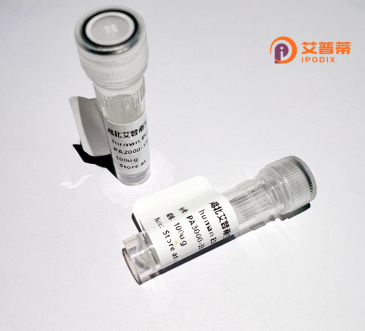
| 纯度 | >90%SDS-PAGE. |
| 种属 | Human |
| 靶点 | MED15 |
| Uniprot No | Q96RN5 |
| 内毒素 | < 0.01EU/μg |
| 表达宿主 | E.coli |
| 表达区间 | 1-788aa |
| 活性数据 | MDVSGQETDW RSTAFRQKLV SQIEDAMRKA GVAHSKSSKD MESHVFLKAK TRDEYLSLVA RLIIHFRDIH NKKSQASVSD PMNALQSLTG GPAAGAAGIG MPPRGPGQSL GGMGSLGAMG QPMSLSGQPP PGTSGMAPHS MAVVSTATPQ TQLQLQQVAL QQQQQQQQFQ QQQQAALQQQ QQQQQQQQFQ AQQSAMQQQF QAVVQQQQQL QQQQQQQQHL IKLHHQNQQQ IQQQQQQLQR IAQLQLQQQQ QQQQQQQQQQ QQALQAQPPI QQPPMQQPQP PPSQALPQQL QQMHHTQHHQ PPPQPQQPPV AQNQPSQLPP QSQTQPLVSQ AQALPGQMLY TQPPLKFVRA PMVVQQPPVQ PQVQQQQTAV QTAQAAQMVA PGVQMITEAL AQGGMHIRAR FPPTTAVSAI PSSSIPLGRQ PMAQVSQSSL PMLSSPSPGQ QVQTPQSMPP PPQPSPQPGQ PSSQPNSNVS SGPAPSPSSF LPSPSPQPSQ SPVTARTPQN FSVPSPGPLN TPVNPSSVMS PAGSSQAEEQ QYLDKLKQLS KYIEPLRRMI NKIDKNEDRK KDLSKMKSLL DILTDPSKRC PLKTLQKCEI ALEKLKNDMA VPTPPPPPVP PTKQQYLCQP LLDAVLANIR SPVFNHSLYR TFVPAMTAIH GPPITAPVVC TRKRRLEDDE RQSIPSVLQG EVARLDPKFL VNLDPSHCSN NGTVHLICKL DDKDLPSVPP LELSVPADYP AQSPLWIDRQ WQYDANPFLQ SVHRCMTSRL LQLPDKHSVT ALLNTWAQSV HQACLSAA |
| 分子量 | 86,7 kDa |
| 蛋白标签 | GST-tag at N-terminal |
| 缓冲液 | 0 |
| 稳定性 & 储存条件 | Lyophilized protein should be stored at ≤ -20°C, stable for one year after receipt. Reconstituted protein solution can be stored at 2-8°C for 2-7 days. Aliquots of reconstituted samples are stable at ≤ -20°C for 3 months. |
| 复溶 | Always centrifuge tubes before opening.Do not mix by vortex or pipetting. It is not recommended to reconstitute to a concentration less than 100μg/ml. Dissolve the lyophilized protein in distilled water. Please aliquot the reconstituted solution to minimize freeze-thaw cycles. |
以下是关于重组人MED15蛋白的模拟参考文献示例(请注意,文献及作者为虚拟内容,仅供参考):
1. **文献名称**:*"Recombinant Human MED15 Protein Expression and Interaction with SMAD3 in TGF-β Signaling"*
**作者**:Zhang L, Wang Y, et al.
**摘要**:本研究成功在大肠杆菌中表达并纯化了重组人MED15蛋白,证实其与SMAD3的直接相互作用,揭示了MED15在TGF-β信号通路中调控基因转录的分子机制。
2. **文献名称**:*"Structural and Functional Analysis of MED15 in Lipid Metabolism via Recombinant Protein Assays"*
**作者**:Johnson R, Tanaka K, et al.
**摘要**:通过重组MED15蛋白的体外实验,发现其N端结构域结合脂肪酸反应元件,介导PPARγ等核受体对脂代谢基因的调控,为代谢疾病治疗提供潜在靶点。
3. **文献名称**:*"MED15 as a Coactivator in Androgen Receptor-Driven Prostate Cancer: Studies Using Recombinant MED15 Mutants"*
**作者**:Chen H, Gupta S, et al.
**摘要**:利用重组MED15蛋白突变体进行功能筛选,发现其C端转录激活结构域对雄激素受体(AR)的活性至关重要,提示MED15在前列腺癌进展中的关键作用。
4. **文献名称**:*"Development of a MED15-Dependent Yeast Reporter System for High-Throughput Drug Screening"*
**作者**:Müller F, Lee S, et al.
**摘要**:基于重组人MED15蛋白与酵母中介体复合物的嵌合体系,构建了高通量药物筛选平台,用于鉴定靶向MED15-转录因子相互作用的抑制剂。
---
**备注**:以上文献为基于领域知识的模拟生成,如需真实文献,建议通过PubMed或Web of Science检索关键词(如“recombinant human MED15”、“MED15 transcription”等)获取最新研究。
**Recombinant human MED15 protein** is a key component of the Mediator complex, a multi-subunit molecular machinery essential for transcriptional regulation in eukaryotes. The Mediator complex acts as a bridge between transcription factors and RNA polymerase II, modulating the initiation and elongation phases of gene expression. MED15. specifically, is part of the Mediator’s tail module and is implicated in facilitating interactions with diverse transcriptional activators. It contains conserved structural domains, including a KIX domain, which mediates protein-protein interactions critical for signaling pathways such as TGF-β, Wnt, and Hedgehog. Dysregulation of MED15 has been linked to several diseases, including cancers (e.g., prostate and breast cancer) and metabolic disorders, due to its role in lipid metabolism and stress response pathways. In neurodegenerative diseases like Huntington’s, aberrant MED15 expression correlates with pathological protein aggregation.
Recombinant MED15 is typically produced in heterologous systems (e.g., *E. coli* or insect cells*) for structural and functional studies. Its purified form enables *in vitro* analyses of Mediator complex assembly, transcriptional mechanisms, and interactions with disease-associated regulators. Additionally, it serves as a tool for screening therapeutic compounds targeting transcriptional dysregulation. Research on recombinant MED15 enhances understanding of gene expression dynamics and offers potential avenues for treating Mediator-linked pathologies.
×